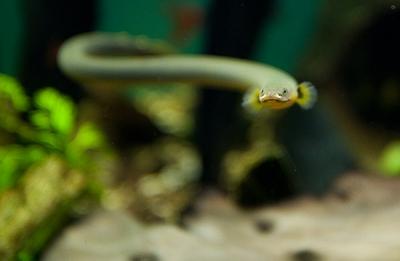Ropefish, Reedfish, Snakefish (Erpetoichthys calabaricus)

Ropefish (Erpetoichthys calabaricus) are interesting eel-shaped fish from Africa. They belong to the family Polypteridae.
Ropefish are also commonly called "reedfish" or "snakefish" due to their eel-shaped or snake-like body shape.
If you decide to house one (or several) in your aquarium you will need a spacious one. Ropefish (or reedfish, whichever you prefer) grow quite large - up to 16 inches (40 cm) in length so don't plan on keeping them in a small tank.
Their tank should be heavily planted with lots of rockwork and caves. Ropefish need lots of hiding places. They like to move and hide among the plants and rockwork. They are mostly nocturnal fish, but will sometimes come out into the open during the daytime.
You may keep several ropefish together in the same aquarium and they can even be kept in a community tank. Despite their appearance they are peaceful fish. However, ropefish will eat small tankmates that are easy to swallow. Also don't keep ropefish with aggressive fish that will harass them.

You should keep their tank covered so they don't escape from the aquarium. Their body shape makes them quite agile and they are able to escape from their tank easily - even through small holes.
Another interesting fact about ropefish is that in addition to utilizing oxygen from the water through their gills, they also utilize atmospheric oxygen. They do this by swallowing air at the water surface. The air enters their esophagus, which is connected to their swim bladder. Once the air reaches the swim bladder the oxygen is absorbed into their blood stream. This modified swim bladder evolved so that ropefish could survive in low-oxygenated water. In fact, ropefish can even survive for a short time out of the water.
Ropefish also have two sensory organs that extend from their nostrils.
Ropefish have several dorsal fins along their back. The following You Tube video shows a good closeup of these fins. Note that there are no ventral fins.
Male and female ropefish look very similar to one another. However, females are reported to have fewer fin rays in their anal fin than males do. Their anal fin is located on their underside near their caudal fin.
In their natural environment they eat insects, worms, small fish, and crustaceans. In captivity feed them live meaty foods. Live bloodworms are a ropefish favorite. They will also eat chopped up fish or seafood. They are often reluctant to eat dried food and some ropefish may only eat live foods. Because there are no reports of ropefish spawning in captivity most likely your ropefish will have been taken from its natural habitat where it was used to feeding on live foods. In time, most ropefish will learn to eat meaty frozen fish foods.
The best water parameters for your ropefish is a water temperature of between 72-82 °F (22-28 °C), and slightly acidic, medium-hard water.
Ropefish can be purchased for about $16 each, but sometimes much more. The only place I've found ropefish for sale online this cheap is at AquariumFish.net.
